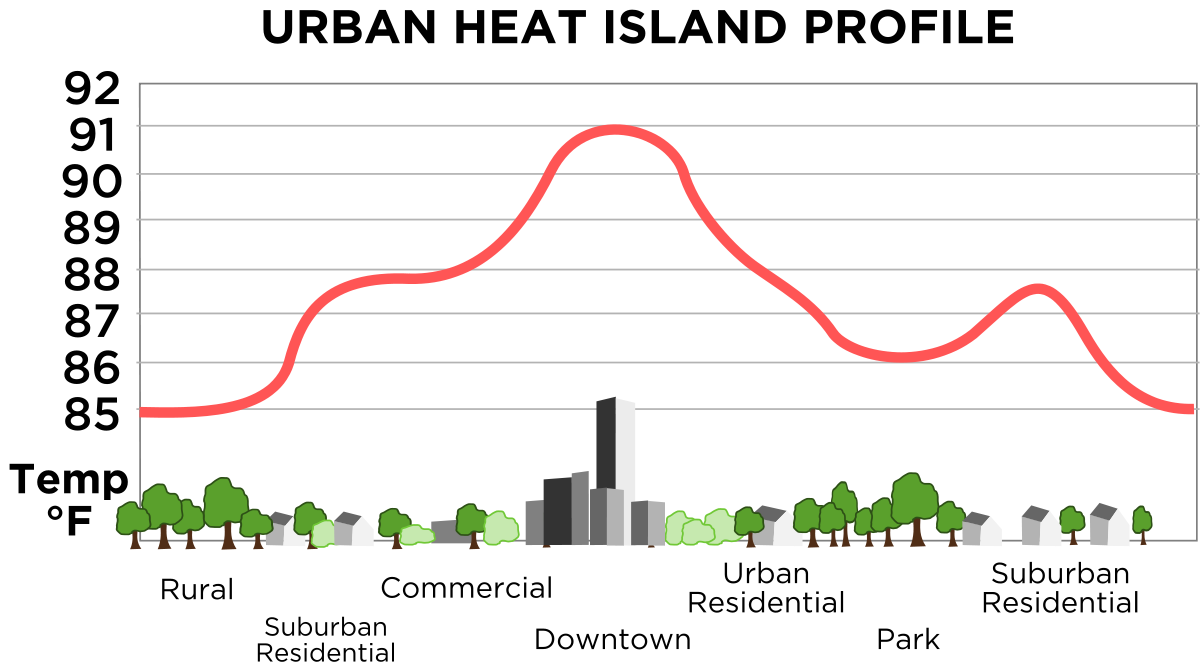News Highlights
The effect of urban heat island is evident as the mercury marks 35 degree celsius even at night.
Urban Heat Island on Delhi
- As per image captured by NASA on May 5 showed how nighttime temperatures in Delhi and adjoining villages were above 35 degrees Celsius, peaking at about 39 degrees Celsius, while the rural fields nearby had cooled to around 15 degrees Celsius.
- Cause of Urban Heat Island in Delhi
- Global warming
- Micro climate change which occur when we start disrupting our landscapes
- 60% of Delhi’s landscapes are disrupted, signalling alteration or encroachment of tree cover, forest cover, wetlands and natural ecosystems
- Way to Counter
- Developing Green Infrastructure that includes
- Cool roofs or painting house roofs in a light colour to reflect heat and using sustainable cooling mechanisms
- Promoting urban forestry and green transport can also help curb heat emissions.
- Industries, which also act as heat traps, need to minimize heat emission through thermal innovation
- Developing Green Infrastructure that includes

Heat Death
- As per Accidental Deaths and Suicides in India’ released by the National Crime Records Bureau the death due to heatstrokes have become the second leading cause of death from a natural force in India, with 11,555 people being killed from 2011 to 2020 due to the condition.
- In 2020, Ahmedabad and Hyderabad, which have heatwave action plans that track every heat related death, reported heatstroke to be the reason for the maximum – 50% – deaths due to natural forces. Effect of action plan prepared
- Taking insights from India’s first heat action plan that came up in Ahmedabad in 2013, the Centre is currently working with 23 heatwave prone States and over 130 cities, including Delhi, to implement a similar action plan
Urban Heat Islands
- An urban heat island is a local and transient phenomenon that occurs when particular parts within a city suffer a higher heat load than neighbouring locations on the same day.
- Temperature changes of 3 to 5 degrees Celsius are possible.
Triggering Factors of Urban Heat Islands
- Loss of Green Cover – The urban areas have minimal green cover as compared to rural regions. Even though green cover is present in the region it is used to be cleared as part of urban expansion.
- Heat Regulation – High-rise buildings, highways, parking spaces, pavements, and public transportation routes are all common features of urban environments. As a result, heat regulation is either non-existent or artificial.
- Dark Surface – Buildings in cities are typically made of dark-colored materials such as glass, bricks, cement, and concrete, all of which attract and absorb more heat.
- Vehicular Emission – Warmth is also added to metropolitan areas by transportation infrastructure and the unrestricted use of fossil fuels.
- Cooling to Living Space – Air conditioning requires a large quantity of energy from power plants, resulting in increased pollution. Air conditioners produce hot air, which generates additional heat, creating a cascading effect.
Impacts of Urban Heat Islands
- High Energy Costs – The urban heat island effect raises energy prices (for example, air conditioning), pollution levels, and heat–related sickness and mortality. Increased air-conditioning demand for cooling may contribute to global warming, which in turn leads to climate change.
- Poor Air Quality – Because more contaminants are blasted into the air, air quality in urban heat islands is often poor. The urban landscape, which includes buildings, roads, walkways, and parking lots, prevents these pollutants from dispersing and becoming less harmful.
- Heatwaves- Cities are prone to heat waves, which have a negative impact on human and animal health, causing heat cramps, sleep loss, and higher mortality rates.
Way to Reduce Urban Heat Island
- Increase green cover by practicing urban forestry
- Depending on sustainable energy sources like solar energy rather than thermal plants
- Roofs and terraces should be painted white or bright colours to reflect heat and reduce absorption.
- Gardening in the kitchen and plants on the patio should be encouraged.
Pic Courtesy : The Hindu
Content Source : The Hindu



